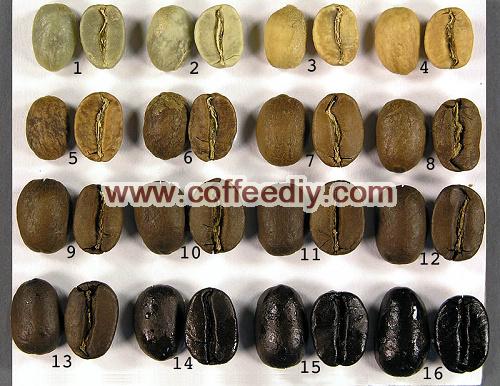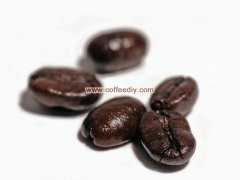High-quality coffee beans common sense why coffee beans produce oil?
People who like to grind their own coffee beans have this feeling that there will be a layer of "grease" on the surface of coffee beans, which is called coffee oil. In fact, this layer of oil-like substance is not coffee oil, so why do coffee beans produce oil?

The changing process of oil production from coffee beans
These "oils" distributed evenly on the surface of coffee beans are actually not "oils", but water-soluble organic substances that look like oils.
Oiled coffee beans can basically be determined to be stale coffee beans, of course, in addition to deep-roasted fresh coffee beans, there are two main reasons for the emergence of oil from coffee beans:
A stale shallow baked beans b fresh deep baked beans.
The fresh light roasted beans, which are light brown in appearance, will not produce oil after baking, and the oil will appear about six days after baking (there are dots of oil on one side of the coffee beans). At this time, the coffee beans are not fresh, but the quality will decline accordingly compared with the freshly baked beans. Of course, lightly roasted coffee beans show dots of oil, which is sometimes a sign that the flavor has reached its peak. When the coffee beans are out of the oven for more than two weeks, there is a bright glow on the surface of the shallow baked beans. At this time, the flavor quality of the shallow baked beans has been difficult to be guaranteed and should be avoided.
Fresh deep-baked beans with dark brown appearance show slightly glossy appearance after baking, and a large amount of oil begins to appear on the surface from the second day to the fifth day after baking. The well-oiled deep-baked beans do not mean that they are not fresh. On the contrary, the deep-baked beans will gradually dry out three weeks after they are baked, and finally become dry-flavored beans.
Understand why coffee beans are out of oil when buying roasted coffee beans, be sure to see the baking date clearly, try to have a better baking date within a week, and drink it within two days after opening it for the best.
Important Notice :
前街咖啡 FrontStreet Coffee has moved to new addredd:
FrontStreet Coffee Address: 315,Donghua East Road,GuangZhou
Tel:020 38364473
- Prev

Coffee Common sense Coffee processing methods and Flavor advantages and disadvantages of Coffee beans
The coffee beans we are familiar with are all cooked coffee beans, that is, roasted coffee beans. Different roasting processes can add different flavors to coffee beans. Perhaps few coffee lovers know the processing methods of raw coffee beans. Today, the editor will explain the processing methods and flavor advantages and disadvantages of raw coffee beans. The coffee fruit after harvest must be put into the processing program immediately, otherwise it will open.
- Next

Coffee beans roasting knowledge of coffee beans out of oil is good?
Some of the coffee beans in the coffee bar are shiny and glossy, while others are dull. After a while, it was found that the surface of the dull coffee beans also looked glossy. Perhaps friends who often drink coffee at home will also have such doubts: is the oiled coffee bean good? Will it affect the taste of the coffee? Why do coffee beans produce oil? Sometimes it can be found in coffee bean stores.
Related
- Beginners will see the "Coffee pull flower" guide!
- What is the difference between ice blog purified milk and ordinary milk coffee?
- Why is the Philippines the largest producer of crops in Liberia?
- For coffee extraction, should the fine powder be retained?
- How does extracted espresso fill pressed powder? How much strength does it take to press the powder?
- How to make jasmine cold extract coffee? Is the jasmine + latte good?
- Will this little toy really make the coffee taste better? How does Lily Drip affect coffee extraction?
- Will the action of slapping the filter cup also affect coffee extraction?
- What's the difference between powder-to-water ratio and powder-to-liquid ratio?
- What is the Ethiopian local species? What does it have to do with Heirloom native species?

